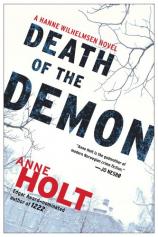Death of the Demon: A Hanne Wilhelmsen Novel
Review
Death of the Demon: A Hanne Wilhelmsen Novel
Many novels that can be grouped generally under the Nordic noir classification are being published for the first time in the United States many years after their initial publication in their authors’ native countries, or are being reprinted in new editions due to the rekindled (no pun intended) interest in all things Scandinavian. DEATH OF THE DEMON falls into the latter category. Part of the Hanne Wilhelmsen series, the book was originally published in 1995, 12 years before the original publication date of 1222, which then released in the US in 2011. As a result, several social and cultural aspects and issues concerning the book no longer apply, or do so somewhat differently. Still, that should not deter you from reading this crucial installment in the series.
"[T]here are passages that I doubt I will ever forget, especially those involving Olav as he is first introduced, and as he makes his way across the city, utilizing urban foraging as the police force searches desperately for him."
Wilhelmsen has been promoted to the position of chief inspector in the Oslo Police Department. It is a job for which she is ill-suited in many ways, and no one realizes that more than herself. She is a little too forthright to bring the degree of political tact that such a position requires and demands. Aiding her is Billy T., a hilariously foul-mouthed maverick police investigator who is also her close friend. The two are somewhat opposite but complement each other rather than clash; what one misses, the other catches. So it is that the opening moments of their investigation into a murder at an Oslo foster home is a fine and riveting bit of police procedure, 1995 or otherwise.
The book begins with a quietly frightening and horribly tragic introduction to the life of a 12-year-old boy named Olav, who has been warehoused by the Norwegian social system into the foster home in question, for the simple reason that his mother cannot deal with him. Olav is the “demon” of the title. Or perhaps not. There are plenty of possibilities to go around, not the least of whom is Olav’s mother, whose secret neglect of him as an infant is demonstrated in a cringe-inducing incident (the book, particularly the first half, is full of those) that is recounted early on and may well be responsible for the behavioral pattern that landed him in supervised care to begin with.
Olav butts heads with the staff from the beginning of his residence at the home, particularly with Anna Vestavik, the foster home director, who supervises both the personnel and the children who they care for with a fairly firm hand. It is clear that dealing with Olav is beyond even Vestavik’s experienced hand, and perhaps never more so than when Vestavik is discovered murdered in her office, stabbed through the heart while seated at her desk. Olav is missing and on the run; it is assumed, in due course, that he is the one behind the murder.
Yet there are other potential suspects, whose identities and motives unfold gradually over this exquisitely paced mystery as Wilhelmsen and Billy T. steadfastly pursue some tenuous clues that seemingly lead nowhere (at least in some cases), while Olav slowly but steadily makes his way through a bitterly cold Oslo toward his mother’s home. He utilizes a vague street smart that reveals a canny intelligence far beyond his years on a mission that is all but certain to end badly for those involved.
DEATH OF THE DEMON is not my favorite book in the Hanne Wilhelmsen series (that honor still belongs to 1222), but I suspect that such ranking is due, at least in part, to the somewhat dated aspect of several of the social issues that were rock-solid current at the time the book was written. That being said, there are passages that I doubt I will ever forget, especially those involving Olav as he is first introduced, and as he makes his way across the city, utilizing urban foraging as the police force searches desperately for him. These elements make DEATH OF THE DEMON a fast and heart-stopping read, whether or not you are familiar with Holt’s novels.
Reviewed by Joe Hartlaub on June 28, 2013





